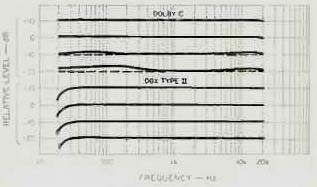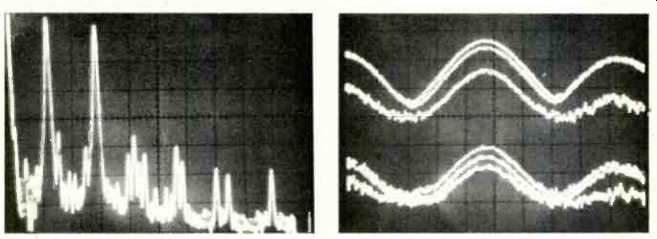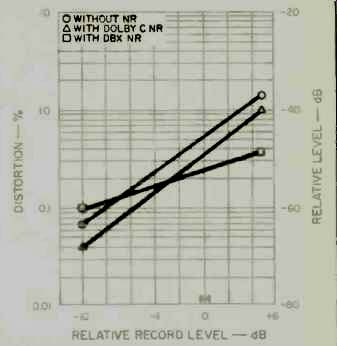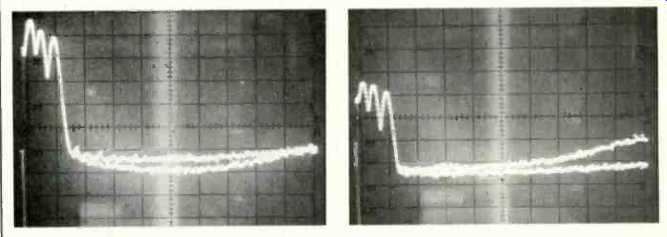
By HOWARD A. ROBERSON
Dolby B noise reduction was a vital factor in the acceptance of the cassette format. But as tapes, records and the rest of the audio chain improved, audiophiles felt the need for even greater noise reduction. Dolby C noise reduction, now available on many decks, reduces noise by 20 dB, twice as much as t 10 dB of Dolby B NR. The dbx II NR system, with as much as 30 dB of noise reduction and increased headroom, has been available for several years in outboard processors and has recently been built into decks from several manufacturers.
While everyone knows that these systems reduce noise, their effects on frequency response, distortion and other aspects of system performance are less common knowledge. This article examines these factors, with some suggestions as to how one can best take advantage of each system's characteristics.

Fig. 1--Swept-frequency responses, 20 Hz to 20 kHz, of Dolby C and dbx
Type II NR systems, simultaneous encoding and decoding. (Dashed lines in
lower Dolby curves are left channel.)
Responses and Tracking
The investigation utilized the normal collection of test equipment plus a Nakamichi NR-200 for the Dolby C processor and a dbx 224 for the dbx II processing. A Nakamichi 582 cassette deck was used for the record/playback tests. First, the processors themselves were tested to make sure their encoding and decoding were exactly complementary. Figure 1 shows the 20 Hz to 20 kHz swept responses of both channels, in steps of 10 dB from + 10 to-20 dB. Although normal calibration procedure was followed, there was a rise of 2 dB or so around 100 Hz at -20 dB with Dolby C NR for one channel. This deviation indicates the need for accurate adjustment with this system. The dbx II responses were perfectly flat at all levels except for the rolloff of 3 dB or so at 20 Hz.
Figure 2 shows a similar set of responses, but they are of the encoder section only. We can see that, with Dolby C NR, there is no compression at the lowest frequencies, but from 100 Hz up there is increasing compression as overall level is reduced. The decoder, of course, has mirror-like responses; by expanding the lower levels, it restores signals to their correct level but reduces noise. Because the curve shapes change with level below zero, level-matching errors will cause at least some frequency-response deviation.
The dbx Type II encoder responses are in steps of 5 dB because of the 2:1 compression. The curve shapes, how ever, are exactly the same, and the matching (mirror-image) curves of the decoder also do not change with level.
Thus, dbx II does not require level matching to maintain normal response.
Since dbx also compresses signals above zero, it appears logical that there should be increased headroom.
The decoder not only "corrects" the response, but it expands the signal 1:2 relative to zero, back to its correct levels, thereby reducing noise.
What follows immediately is basically a deliberate demonstration of how improper testing methods can make a product look bad. The test signal consisted of the swept sinusoid fed through an MXR 1/3-octave equalizer with the filters purposely set to simulate the response of a poor recorder. The equalizer was inserted in the NR loops, and swept responses were taken. As Fig. 3 shows, Dolby C NR matched quite well at the two levels tried. Dbx II, however, doubled the deviations from flat. It would seem that this demonstrates a failing in the dbx II scheme, but it's really an example of a poor test.
Figure 4 shows what happened when I repeated the test but used pink noise, instead of a swept sine wave, as the source. All three traces look alike, including that for dbx II (bottom). The dbx system's gain varies with overall signal level, not with the level in just one frequency band. A swept sinusoid of varying amplitude appears as just another varying-amplitude signal to the dbx II system, which acts accordingly.
Since the variations in the test were introduced after the encoder but before the decoder, the deviations were doubled in the expansion. With wide band signals such as pink noise or music, frequency irregularities have less effect on overall level and so are not expanded.
Figure 5 shows Dolby C NR responses at -20 with the Nakamichi 582 record/playback in the loop. The topmost response was made with a low-pass filter at 25 kHz. The second trace of Fig. 5 was the result of moving the filter out to 50 kHz. The third trace was obtained after switching in the multiplex filter. The highest frequencies were rolled off by that filter, but the smoothing of the overall response is very obvious and certainly desirable. Dolby Laboratories does recommend that the multiplex filter be used as a general practice to prevent mistracking due to energy above 20 kHz-as might come from a synthesizer, for example. The other traces in Fig. 5 show the effects from calibration errors and a rolled-off response from excessive bias.
Figure 6 shows the dbx II responses over a range of the higher levels. The system showed no sensitivity to above band energy or recorder-response deviations over a very broad range of levels. (Part of the dbx II design is a 10-kHz roll-off in the level-detector loop and a 27-kHz roll-off in the signal loop.) In the top set of four traces, the unity-gain point was set at -5 input/ record level, and the input level was increased in steps of 4 dB above that, to a maximum of +7. It can be seen that a roll-off appeared at +3 input level, which was actually -1 on the recorder because of the encode compression. In the bottom four traces, unity gain was set at zero with input levels of 8, 4, 0 and + 4. Notice that there is some roll-off at 4, which was actually -2 on the recorder. In this case, with the high unity-gain point, levels were actually pulled up by the encoder compression, leading to the high-frequency loss. The dbx Type II unity-gain point should be set 5 dB or so below the recording level where high-frequency saturation first appears; that will give 10 dB of headroom, with the 2:1 encoder compression.

Fig. 2--Swept-frequency responses of Dolby C and dbx II encoders only.
Fig. 3--Response of NR systems with poor "recorder" response, using swept sine-wave signals.

Fig. 4--Response of NR systems to same poor "recorder" response,
using pink-noise test signals: "Recorder" response (top trace),
with Dolby C NR at-10 dB (middle), and with dbx II NR at-10 dB (bottom).
Vertical scale: 5 dB/division.
Fig. 5--Effect of high-frequency energy on Dolby C tracking, at -20 dB with tape deck in loop: Pink noise response with 25-kHz low-pass filter on source (top trace); response with 50-kHz low-pass filter (second); response with multiplex filter added (third); response with Dolby calibration control at +1, multiplex filter out, and 25-kHz filter in (fourth); same, with calibration at -1 (fifth), and response with excessive recorder bias, rolling off at high end, calibration at zero (bottom). Vertical scale: 5 dB/division.
Distortion and Noise Reduction
As a first step, let us discuss some of the basic characteristics of distortion in the recording process. In analog recording with high-frequency bias, the primary distortion components are third-order, even with complex tones.
Over the entire range of recorded levels, the absolute level of the third harmonic is a cubic function of the level of the fundamental. The relative level of the distortion, as a percentage of the fundamental, varies as the square of the signal level. This means the distortion will increase 2 dB for each 1 dB increase in record level. Therefore, excessive recording levels can cause very high levels of distortion: At 3 dB above the 3% distortion point, HDL3 would be about 6%. Part of the appeal of noise-reduction systems is that by reducing noise, they give some leeway in setting maximum record levels, so there's less chance of distortion. Even when recording levels aren't excessive, both the Dolby and dbx II NR systems lower distortion--but for different reasons.
In the Dolby system, distortion is reduced, like noise, during decoding.
That's because distortion, like noise, is added to the signal after encoding and because the Dolby systems' sliding frequency bands concentrate the decoding on the upper (and, with Dolby C, the middle) frequencies, where undesired harmonics appear. This is why, in tape-recorder "Equipment Profiles," I regularly comment that "distortion without NR was 30% higher." The dbx Type II system, on the other hand, reduces distortion across the audio band at higher input levels, since its compressing action reduces the actual recording level. (There is no response shaping with any significant effect on distortion.) Below the dbx system's unity-gain point, signal compression increases the recording level, which increases distortion; but the distortion here is low enough to be acceptable, in most cases even with the compression.

Fig. 6--Effects of dbx II unity-gain setting and input level on frequency
response. Upper four curves: Responses at (top to bottom) +7, +3,-1 and-5
dB, with unity gain set at-5 dB; note roll-off in upper two curves. Lower
four curves: Responses at (top to bottom) +4, 0, -4, and -8 dB, with unity
gain at 0; note the earlier onset of roll-off. Vertical scale: 5 dB/division.
Fig. 7-Record/playback spectrum with test signal of 400, 1,100 and 2,000 Hz, at +5 dB input level, with dbx Type II NR. Scales: Horizontal, 0.5 kHz/division; vertical, 10 dB/ division.

Fig. 8--Same as Fig. 7, with Dolby C NR. Note greater distortion (see
text).
Fig. 9--Distortion components around 2.6 kHz, with same three-tone source. Upper set of curves at +5 dB input level: Without NR (top), with Dolby C NR (middle), and with dbx II NR (lower). Lower set of curves same, but at 0 dB input level. Scales: Horizontal, 20 Hz/division; vertical, 10 dB/division.
Multiple-tone distortion tests (more like music than single-tone signals) confirm this. When the signal was recorded with an input level of +5, tapes made with dbx II (Fig. 7) showed less distortion than tapes made with Dolby C (Fig. 8)--up to 10 dB less, especially for the highest level components. But this is only due to the dbx compression, which reduces the actual recording level to 0 dB. When the input to the dbx system is raised to + 15 dB (for a recording level of +5 dB, after compression), record distortion is almost exactly that of a tape recorded at +5 with Dolby C--or of a tape made at +5 without NR, for that matter.
A series of spectrum-analyzer scans indicated that the changes in all distortion-component levels with reducing record level could be measured by examining any selected component. The analyzer was tuned to the 2.6-kHz product (2f2 + f1), and a narrow scan (20 Hz/div.) was used to get the required detail. Figure 9 shows the results at +5 input level (zero record level for dbx II) and at zero input level (-2.5 recorded level for dbx II). In both cases, the highest distortion level is without noise reduction, the middle I level is with Dolby C NR, and the lowest level is with dbx II NR. Note that the dbx II trace appears to be noisier.
Figure 10 plots HDL3 versus input level at 400 Hz for the two NR systems and for a signal without NR. It can be seen that Dolby C NR reduced distortion for all levels shown. This distortion reduction over a wide level range is a benefit of the sliding-band design of the Dolby C compressor and expander. However, as the level approaches the 3% distortion point, there is less advantage.
It is very evident that the compression in the dbx II encoder around the -5 unity gain point produced a great reduction in distortion at the higher levels. Note, however, that its curve crosses the Dolby C NR curve at -3, and that the distortion below -3 is relatively higher, noticeably so at -10.
If dbx II offers 30 dB of noise reduction to Dolby C's 20 dB, it may seem paradoxical that, in Fig. 9, the high-level signal trace with dbx II was noisier than that with Dolby C. But, as Fig. 11 also shows, output noise at higher levels with Dolby C NR is less than with dbx II. This proves that the Dolby C sliding-band scheme can reduce noise even at higher signal levels. At low recording levels (Fig. 12), noise with dbx II was lower, particularly at the higher frequencies.

Fig. 10--Third-harmonic distortion vs. record level, at 400 Hz: Without
NR (top), with Dolby C NR (middle), and with dbx Type II NR (bottom).

Fig. 11--Three-tone source at -5 dB input level, 20-kHz spectra. Noise
levels are higher for dbx I1 than for Dolby C NR. Scales: Horizontal, 2
kHz/ division; vertical, 10 dB/division.
Fig. 12--Same as in Fig. 11, but with -40 dB input level (and analyzer input gain increased). Noise level is now higher with Dolby C than with dbx Type II NR.
Making Choices
Among the advantages of Dolby C NR are its inclusion in many manufacturers' products, very good noise reduction at lower signal levels, some noise reduction even at high levels, and distortion reduction at all normal recording levels. Dolby C also sounded, to my ears, more musical in one comparison where levels could be set as desired. (This may have been from such factors as Dolby C NR's lower noise at higher signal levels and/or from lower distortion at low levels. I did not have the opportunity to correlate the sonic judgment with any test results.) If you're running pink-noise tests or recording synthesizers (which would include energy above 20 kHz), make sure the signal's high end is rolled off before the Dolby C encoding, to prevent mistracking. If in doubt, use your multiplex filter.
The advantages of dbx Type II NR include increasing availability (even in open-reel recorders), excellent noise reduction at lower signal levels, greatly reduced distortion across the band at higher input levels, no requirement for' level matching, and insensitivity to above-band energy. This system is particularly appealing when you're recording live performances and can't stay by the recorder to adjust levels manually. The encoder's 2:1 compression gives you a lot more leeway in setting the input level.
Dolby C's disadvantages are, primarily, its need for accurate level calibration and its sensitivity to above band energy. In practice, however, accurate calibration is quite simple and direct with good units, and above band energy can be eliminated by using the multiplex filter, with substantially no loss in music content.
The drawbacks of dbx Type II NR are affected by the choice of the unity gain point. If too high a level is picked, noise levels for medium-high signal levels will be increased, there will be little improvement in headroom, and distortion will be higher than without NR for anything but high levels. If too low a unity-gain point is selected, noise levels for high signal levels will increase, and there may be some loss of noise reduction at low signal levels.' I have occasionally experienced noise modulation with dbx, though only at odd times between movements or when audience applause was dying out, never during the music itself.
I hope the reader accepts that both Dolby C and dbx Type II noise-reduction systems can provide great benefits to their users, and that this article helps you to understand and to apply them wisely.
========================
(adapted from Audio magazine, Apr. 1983)
= = = =
Also see:
The DNR Noise Reducer: How it Works and How to Build it. (Feb. 1985)
Frequency Contouring for Image Enhancement (Feb. 1985)